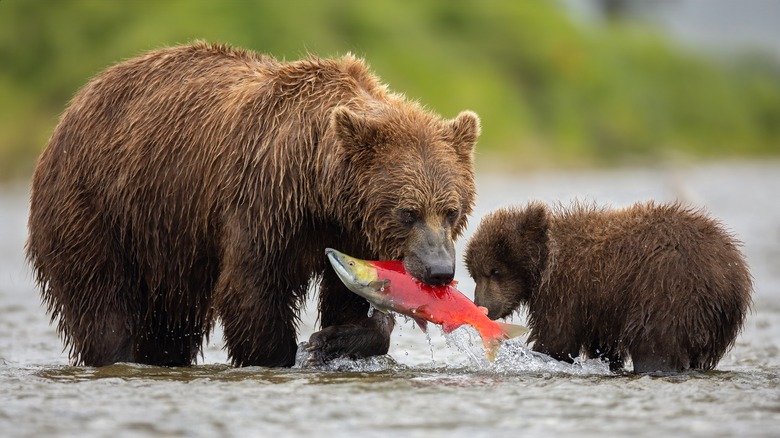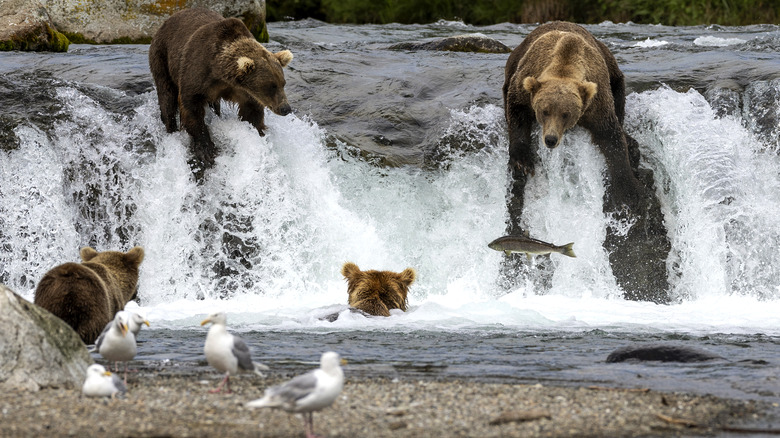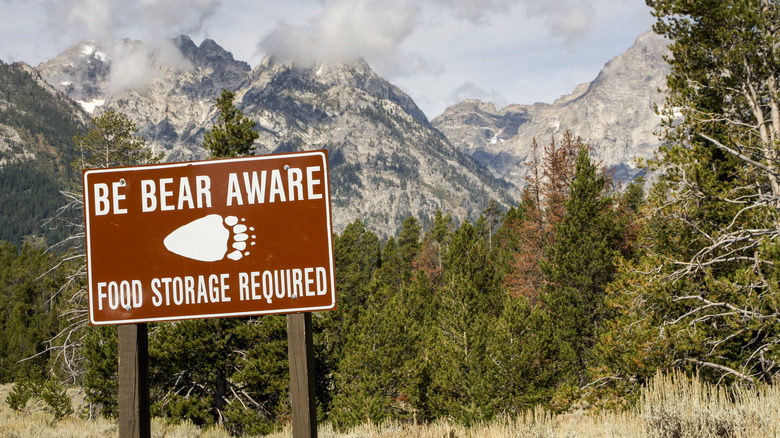A Ranger Reveals What It's Like Being Amongst The Most Brown Bears At This National Park
We may receive a commission on purchases made from links.
Ever wonder what it's like to stand among scores of massive wild bears on a daily basis? Ranger Felicia, sharing her story via TikTok under the handle @ube_softserve, lets viewers glimpse that rare experience. In her clip, she describes "what it's like to work at the national park with the world's largest concentration of brown bears." She's referring, of course, to Katmai National Park — aka the place to be if you're hoping to spot a brown bear in the wild, from a safe distance, of course. "July is the 'beariest' month of the year at the park," Felicia advises, "and if you've ever seen a picture of a bear catching a fish in its mouth at the top of a waterfall, this is where that picture has been taken."
@ube_softserve July is the peak of the salmon run, so it's the beariest month of the year! 🐻 Here is another day in my life living in the national park with more bears than actual residents! #parkranger #katmai #nationalpark #rangerfelicia #alaska #rangerfelicia #seasonal #granola
Felicia describes how July is "the peak of the salmon run." So, naturally, that's when bear enthusiasts everywhere make plans to come to Katmai for glimpses of bears doing what they do best: snacking on fresh river salmon. But being a ranger comes with extra responsibilities. "It's my job to control the flow of people at the viewing platforms," Felicia explains, adding that the experience is cool enough to warrant people waiting for hours in line to get a photo. But, don't waste a second of your wait, as Felicia advises, "there are plenty of bears to watch while you're waiting," showing one passing under one of the designated boardwalks.
Viewers were super excited for the up-close peek into Ranger Felicia's day-to-day. "I work in a special needs class and our kids LOVE watching katmai livestreams especially in fat bear week!" shared TikTok user @mrs.mclemore. Another user, @ilselt, said, "Not only do I want to see more, I have so many questions about the bears."
More about the salmon-loving brown bears of Katmai National Park
If you're looking to visit an underrated national park for incredible views of wildlife, look no further than Katmai National Park. It's not just another wildlife sanctuary — it's brown bear central. Inhabiting the Alaska Peninsula, the park hosts an estimated 2,200 brown bears, outnumbering even people in the region. These are no ordinary bears — the coastal brown bears of Katmai rival the largest land predators in North America, with some adults weighing well over 1,000 pounds by fall.
Ranger Felicia touches on this in another video, saying, "It looks like the bears are kind of wasteful," referring to one that eats only parts of a salmon before moving on. "Bears are trying to gain as much weight as possible before hibernation," she explains, "so they high-grade: meaning they eat only the fattiest parts of the salmon." That means the calorie-dense skin and organs. Don't worry, though, she reassures that those leftovers float downstream to feed younger bears.
And there's no doubt that the bears love hanging out at Brooks Falls. When sockeye salmon stage their upstream run, the falls act like a natural salmon buffet. Bears find it prime fishing real estate, with dozens sometimes vying for space at once. These massive fish runs underpin Katmai's ecosystem, giving bears the calories they need to fatten up for hibernation, a seasonal binge that supports both their survival and breeding success.
How to be a bear-friendly guest in our national parks
Coexisting around bears is part of any park ranger's job, as Felicia demonstrates with a clip of her walk home from work. A mama and baby bear can be seen ahead — although maybe too close for comfort for many, park rangers know to keep their distance. Each day is a reminder that she is in their world, not the other way around. Even as she talks through the lens of a working ranger who has seen it all, there's humility and an unmistakable respect for their power. "There's never a dull day here," she concludes.
One of the dangerous dark sides of working as a national park service ranger is being at risk of unwanted wildlife encounters. That's exactly why certain rules are in place both for the safety of people and the safety of wildlife. Felicia explains that "food in the park is tightly controlled because of the bears," adding that she has to eat her lunch in a designated "lunch shack." Visitors should follow the park's guidance by packing food safely when in bear country using bear-proof containers like the UDAP Canister on Amazon. Always follow park and ranger guidance, and keep a safe distance from wildlife while leaving no trace behind.
There's a reason you're limited to the platform, even during the "beariest" of seasons at Katmai. As the park's Bear School will tell you, "The bears are just trying to survive from year to year ... we need to make sure we're limiting our impact on these wild animals as much as possible." The ultimate goal is for people to be predictable, that way bears can feel safe crossing without fear of unexpected surprises." These behaviors uphold Katmai's legacy as a protected home for wildlife, where bears can be bears.


